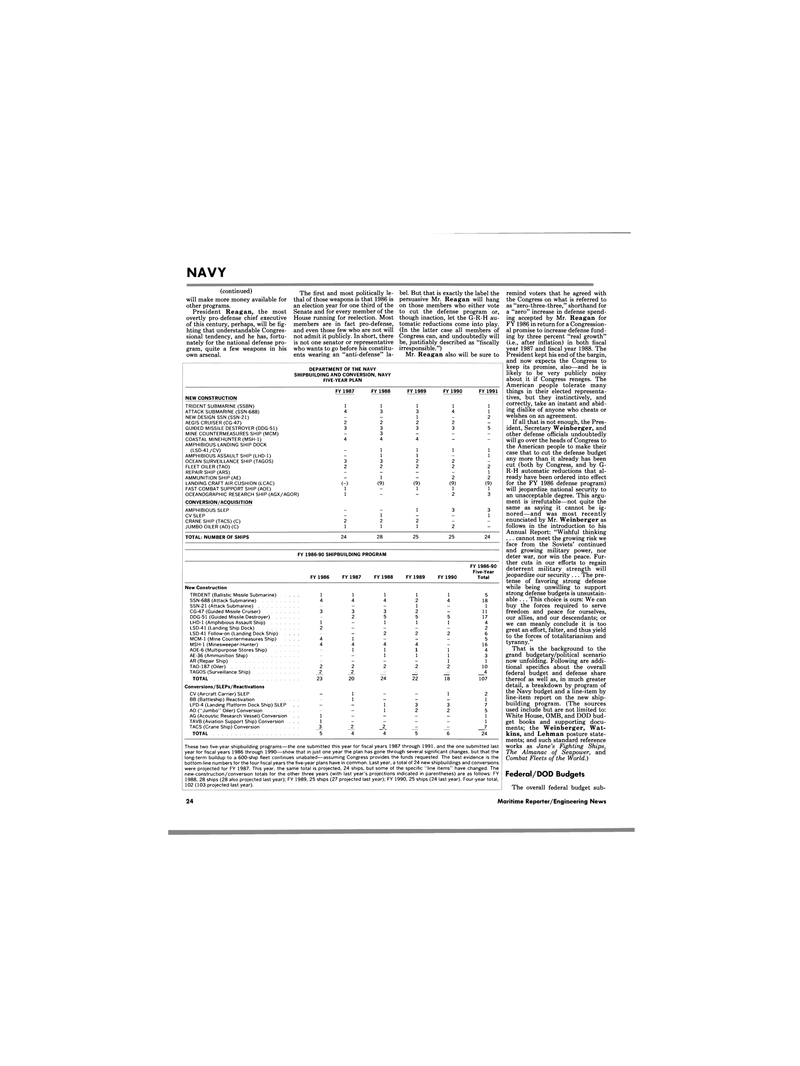
Page 22: of Maritime Reporter Magazine (March 1986)
Read this page in Pdf, Flash or Html5 edition of March 1986 Maritime Reporter Magazine
NAVY (continued) will make more money available for other programs.
President Reagan, the most overtly pro-defense chief executive of this century, perhaps, will be fig- hting that understandable Congres- sional tendency, and he has, fortu- nately for the national defense pro- gram, quite a few weapons in his own arsenal.
The first and most politically le- thal of those weapons is that 1986 is an election year for one third of the
Senate and for every member of the
House running for reelection. Most members are in fact pro-defense, and even those few who are not will not admit it publicly. In short, there is not one senator or representative who wants to go before his constitu- ents wearing an "anti-defense" la- bel. But that is exactly the label the persuasive Mr. Reagan will hang on those members who either vote to cut the defense program or, though inaction, let the G-R-H au- tomatic reductions come into play. (In the latter case all members of
Congress can, and undoubtedly will be, justifiably described as "fiscally irresponsible.")
Mr. Reagan also will be sure to remind voters that he agreed with the Congress on what is referred to as "zero-three-three," shorthand for a "zero" increase in defense spend- ing accepted by Mr. Reagan for
FY 1986 in return for a Congression- al promise to increase defense fund- ing by three percent "real growth" (i.e., after inflation) in both fiscal year 1987 and fiscal year 1988. The
President kept his end of the bargin, and now expects the Congress to keep its promise, also—and he is likely to be very publicly noisy about it if Congress reneges. The
American people tolerate many things in their elected representa- tives, but they instinctively, and correctly, take an instant and abid- ing dislike of anyone who cheats or welshes on an agreement.
If all that is not enough, the Pres- ident, Secretary Weinberger, and other defense officials undoubtedly will go over the heads of Congress to the American people to make their case that to cut the defense budget any more than it already has been cut (both by Congress, and by G-
R-H automatic reductions that al- ready have been ordered into effect for the FY 1986 defense program) will jeopardize national security to an unacceptable degree. This argu- ment is irrefutable—not quite the same as saying it cannot be ig- nored—and was most recently enunciated by Mr. Weinberger as follows in the introduction to his
Annual Report: "Wishful thinking ... cannot meet the growing risk we face from the Soviets' continued and growing military power, nor deter war, nor win the peace. Fur- ther cuts in our efforts to regain deterrent military strength will jeopardize our security ... The pre- tense of favoring strong defense while being unwilling to support strong defense budgets is unsustain- able ... This choice is ours: We can buy the forces required to serve freedom and peace for ourselves, our allies, and our descendants; or we can meanly conclude it is too great an effort, falter, and thus yield to the forces of totalitarianism and tyranny."
That is the background to the grand budgetary/political scenario now unfolding. Following are addi- tional specifics about the overall federal budget and defense share thereof as well as, in much greater detail, a breakdown by program of the Navy budget and a line-item by line-item report on the new ship- building program. (The sources used include but are not limited to:
White House, OMB, and DOD bud- get books and supporting docu- ments; the Weinberger, Wat- kins, and Lehman posture state- ments; and such standard reference works as Jane's Fighting Ships,
The Almanac of Seapower, and
Combat Fleets of the World.)
Federal/DOD Budgets
The overall federal budget sub-
DEPARTMENT OF THE NAVY
SHIPBUILDING AND CONVERSION, NAVY
FIVE-YEAR PLAN
FY 1987 FY 1988 FY 1989 FY 1990 FY 1991
NEW CONSTRUCTION
TRIDENT SUBMARINE (SSBN) 1 1 1 1 1
ATTACK SUBMARINE (SSN-688) 4 3 3 4 1
NEW DESIGN SSN (SSN-21) - - 1 - 2
AEGIS CRUISER (CG-47) 2 2 2 2 -
GUIOED MISSILE DESTROYER (DDG-51) 3 3 3 3 5
MINE COUNTERMEASURES SHIP (MCM) - 3 - - -
COASTAL MINEHUNTER (MSH-1) 4 4 4 - -
AMPHIBIOUS LANDING SHIP DOCK (LSD-41/CV) - 1 1 1 1
AMPHIBIOUS ASSAULT SHIP (LHD-1) - 1 1 - 1
OCEAN SURVEILLANCE SHIP (TAGOS) 3 3 2 2 -
FLEET OILER (TAO) 2 2 2 2 2
REPAIR SHIP (ARS) - - - - 1
AMMUNITION SHIP (AE) - 1 - 2 2
LANDING CRAFT AIR CUSHION (LCAC) (-) (9) (9) (9) (9)
FAST COMBAT SUPPORT SHIP (AOE) 1 - 1 1 1
OCEANOGRAPHIC RESEARCH SHIP (AGX/AGOR) 1 - - 2 3
CONVERSION/ACQUISITION
AMPHIBIOUS SLEP - - 1 3 3
CV SLEP - 1 - - 1
CRANE SHIP (TACS) (C) 2 2 2 - -
JUMBO OILER (AO) (C) 1 1 1 2 -
TOTAL: NUMBER OF SHIPS 24 28 25 25 24
FY 1986-90 SHIPBUILDING PROGRAM
FY 1986-90
Five-Year
FY 1986 FY 1987 FY 1988 FY 1989 FY 1990 Total
New Construction
TRIDENT (Ballistic Missile Submarine) ... 1 1 1 1 1 5
SSN-688 (Attack Submarine) 4 4 4 2 4 18
SSN-21 (Attack Submarine) ... - - 1 - 1
CG-47 (Guided Missile Cruiser) 3 3 3 2 - 11
DDG-51 (Guided Missile Destroyer) ... 2 5 5 5 17
LHD-1 (Amphibious Assault Ship) .... 1 - 1 1 1 4
LSD-41 (Landing Ship Dock) 2 - - - - 2
LSD-41 Follow-on (Landing Dock Ship) ... - 2 2 2 6
MCM-1 (Mine Countermeasures Ship) ... 4 1 - - - 5
MSH-1 (Minesweeper-Hunter) 4 4 4 4 - 16
AOE-6 (Multipurpose Stores Ship) . . . ... 1 1 1 1 4
AE-36 (Ammunition Ship) ... - 1 1 1 3
AR (Repair Ship) ... - - - 1 1
TAO-187 (Oiler) 2 2 2 2 2 10
TAGOS (Surveillance Ship) 2 2 __ 4
TOTAL 23 20 24 22 18 107
Con versions/SLEPs/Reactivations
CV (Aircraft Carrier) SLEP - 1 - - 1 2
BB (Battleship) Reactivation ... 1 - - - 1
LPD-4 (Landing Platform Dock Ship) SLEP . . - - 1 3 3 7
AO ("Jumbo" Oiler) Conversion .... . . - 1 2 2 5
AG (Acoustic Research Vessel) Conversion . . 1 - - - - 1
TAVB (Aviation Support Ship) Conversion ... 1 - - - - 1
TACS (Crane Ship) Conversion 3 2 _2_ - - 7
TOTAL 5 4 4 5 6 24
These two five-year shipbuilding programs— the one submitted this year for fiscal years 1987 through 1991, and the one submitted last year for fiscal years 1986 through 1990—show that in just one year the plan has gone through several significant changes, but that the long-term buildup to a 600-ship fleet continues unabated—assuming Congress provides the funds requested The best evidence is the bottom-line numbers for the four fiscal years the five-year plans have in common. Last year. a total of 24 new shipbuildings and conversions were projected for FY 1987. This year, the same total is projected, 24 ships, but some of the specific "line items" have changed. The new-construction/conversion totals for the other three years (with last year's projections indicated in parentheses) are as follows: FY 1988, 28 ships (28 also projected last year); FY 1989, 25 ships (27 projected last year); FY 1990, 25 ships (24 last year). Four-year total, 102 (103 projected last year). 24 Maritime Reporter/Engineering News

 21
21

 23
23
